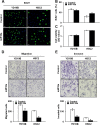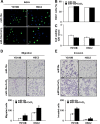MicroRNA-18a regulates the metastatic properties of oral squamous cell carcinoma cells via HIF-1α expression
- PMID: 36064348
- PMCID: PMC9442921
- DOI: 10.1186/s12903-022-02425-6
MicroRNA-18a regulates the metastatic properties of oral squamous cell carcinoma cells via HIF-1α expression
Abstract
Background: Rapid metastasis of oral squamous cell carcinoma (OSCC) is associated with a poor prognosis and a high mortality rate. However, the molecular mechanisms underlying OSCC metastasis have not been fully elucidated. Although deregulated expression of microRNA (miRNA) has a crucial role in malignant cancer progression, the biological function of miRNA in OSCC progression remains unclear. This study aimed to investigate the function of miRNA-18a in OSCC metastatic regulation via hypoxia-inducible factor 1α (HIF-1α).
Methods: miRNA-18a-5p (miRNA-18a) expressions in patients with OSCC (n = 39) and in OSCC cell lines (e.g., YD-10B and HSC-2 cells) were analyzed using quantitative real-time polymerase chain reaction. HIF-1α protein expressions in OSCC cells treated with miRNA-18a mimics or combined with cobalt chloride were analyzed using western blotting. The miRNA-18a expression-dependent proliferation and invasion abilities of OSCC cells were analyzed using MTT assay, EdU assay, and a Transwell® insert system.
Results: miRNA-18a expression was significantly lower in OSCC tissue than in the adjacent normal tissue. In OSCC cell lines, HIF-1α expression was significantly decreased by miRNA-18a mimic treatment. Furthermore, the migration and invasion abilities of OSCC cells were significantly decreased by miRNA-18a mimics and significantly increased by the overexpression of HIF-1α under hypoxic conditions relative to those abilities in cells treated only with miRNA-18a mimics.
Conclusions: miRNA-18a negatively affects HIF-1α expression and inhibits the metastasis of OSCC, thereby suggesting its potential as a therapeutic target for antimetastatic strategies in OSCC.
Keywords: HIF-1α; Hypoxia; Invasion; MicroRNA; Migration; Oral squamous cell carcinoma.
© 2022. The Author(s).
Conflict of interest statement
The authors declare that they have no competing interests.
Figures





Similar articles
-
Hypoxia disrupt tight junctions and promote metastasis of oral squamous cell carcinoma via loss of par3.Cancer Cell Int. 2023 Apr 24;23(1):79. doi: 10.1186/s12935-023-02924-8. Cancer Cell Int. 2023. PMID: 37095487 Free PMC article.
-
Differentiated embryo chondrocyte 1, induced by hypoxia-inducible factor 1α, promotes cell migration in oral squamous cell carcinoma cell lines.Oral Surg Oral Med Oral Pathol Oral Radiol. 2022 Feb;133(2):199-206. doi: 10.1016/j.oooo.2021.08.022. Epub 2021 Aug 31. Oral Surg Oral Med Oral Pathol Oral Radiol. 2022. PMID: 34758939
-
HDAC2 promotes cell migration/invasion abilities through HIF-1α stabilization in human oral squamous cell carcinoma.J Oral Pathol Med. 2011 Aug;40(7):567-75. doi: 10.1111/j.1600-0714.2011.01009.x. Epub 2011 Feb 18. J Oral Pathol Med. 2011. PMID: 21332579
-
Metastasis and cell proliferation inhibition by microRNAs and its potential therapeutic applications in OSCC: A systematic review.Pathol Res Pract. 2024 Oct;262:155532. doi: 10.1016/j.prp.2024.155532. Epub 2024 Aug 11. Pathol Res Pract. 2024. PMID: 39142242
-
Correlation of expression of hypoxia-related proteins with prognosis in oral squamous cell carcinoma patients.Oral Maxillofac Surg. 2012 Jun;16(2):189-96. doi: 10.1007/s10006-012-0335-8. Epub 2012 May 17. Oral Maxillofac Surg. 2012. PMID: 22592457 Review.
Cited by
-
Tumor microenvironment in oral squamous cell carcinoma.Front Immunol. 2024 Dec 18;15:1485174. doi: 10.3389/fimmu.2024.1485174. eCollection 2024. Front Immunol. 2024. PMID: 39744628 Free PMC article. Review.
-
Chronic restraint stress promotes oral squamous cell carcinoma development by inhibiting ALDH3A1 via stress response hormone.BMC Oral Health. 2024 Jan 8;24(1):43. doi: 10.1186/s12903-023-03787-1. BMC Oral Health. 2024. PMID: 38191346 Free PMC article.
-
Hypoxia disrupt tight junctions and promote metastasis of oral squamous cell carcinoma via loss of par3.Cancer Cell Int. 2023 Apr 24;23(1):79. doi: 10.1186/s12935-023-02924-8. Cancer Cell Int. 2023. PMID: 37095487 Free PMC article.
-
Salivary miRNAs and cytokines associated with diagnosis and prognosis of oral squamous cell carcinoma.Front Cell Dev Biol. 2025 Jan 22;13:1531016. doi: 10.3389/fcell.2025.1531016. eCollection 2025. Front Cell Dev Biol. 2025. PMID: 39911325 Free PMC article. Review.
-
miRNA-199b-5p suppresses of oral squamous cell carcinoma by targeting apical-basolateral polarity via Scribble/Lgl.Mol Ther Nucleic Acids. 2024 Oct 18;35(4):102363. doi: 10.1016/j.omtn.2024.102363. eCollection 2024 Dec 10. Mol Ther Nucleic Acids. 2024. PMID: 39558906 Free PMC article.
References
-
- Kuroshima T, Onozato Y, Oikawa Y, Ohsako T, Kugimoto T, Hirai H, Tomioka H, Michi Y, Miura M, Yoshimura R, et al. Prognostic impact of lingual lymph node metastasis in patients with squamous cell carcinoma of the tongue: a retrospective study. Sci Rep. 2021;11(1):20535. doi: 10.1038/s41598-021-99925-2. - DOI - PMC - PubMed
Publication types
MeSH terms
Substances
LinkOut - more resources
Full Text Sources
Medical

